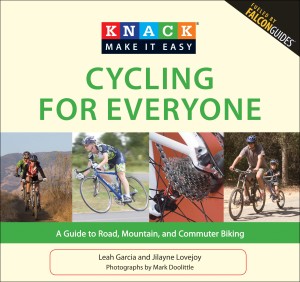There are bicycling books that try to incorporate everything about bicycling into one tidy book or tries to reach out to a broad cycling audience. This format usually does not work except perhaps for the very novice cyclist. I think some of these books are written because they come from a purely business point of view. Someone will think that if there are 15 million cyclists and if the book is marketed properly, 15% of that 15 million will be curious enough to buy the book. Sales are high, satisfaction is low but who cares, the book sold well above costs.
So when Editor Dave Iltis gave me a book entitled “Cycling for Everyone”, I immediately became biased and hesitant to accept it. Dave encouraged me and told me not to put my experience as a cyclist in the book reviews. After all it is not my book. After about a dozen or so pages I realized that “Cycling for Everyone” is different. Yes it is a book that covers a lot of territory, but the authors and publishers have created a format for the book that makes it work. I was pleasantly surprised. I can see this book being read by novice cyclists, recreational cyclists even entry-level bike shop employees or anyone wanting a broad look at cycling. This is a book that shops could have on the counter for customers to look at so that when a customer has a question. The shop employee could then answer the customer’s question in an organized manner.
The book is well organized into 20 chapters with each chapter 10-15 pages in length, long enough to give information, short enough for the attention span. Each page has enough written information in sufficient detail to make it interesting, but not so much information to cause the reader to drift away. There are also numerous pictures that are very complimentary to the written words. You get a bit more than the basic concepts. There are also color-coded small boxes on selected pages for “Thoughtful tips, Expert Shortcuts, Interesting Facts, Proceed with Caution, and Stop and Think”. They are plentiful, helpful and add to the basic printed page to gain the reader’s attention in an interesting way.
In the 11-page first chapter entitled Types of Bikes you will be run through the basics of city, off-road, fixed gear and singlespeeds. In addition, specialty bikes such as tandems, foldable and recumbent are reviewed as well as BMX, hand-cycles and track bikes. The final two pages in the first chapter covers frame materials. In total there are 20 chapters. I doubt if every reader will be interested in every chapter, but I would bet that most of the chapters would be interesting and useful.
Do I have any constructive criticisms with the book? A few but that would represent a very small percentage of the content of the book. For example under crank lengths on page 22 it says; “175-mm cranks are the most common length” and “170 mm cranks are typical on smaller framed bikes”. I think this should be one of those “it depends” statements and not clearly that black and white. My area of interest, bike touring has only two pages and the picture has a touring bike with panniers of companies that have not existed since the mid 1980’s. And finally there are “fashion” statements and I’m not one that dwells on “fashion”. So when it was said on page 79 “road cycling and hydration packs are gererally a fashion faux pas”, I not only rolled my eyes and said so what, I also questioned their editing; as they missed the misspelled “generally”.
If you want to learn a little about mountain bike skills, riding with kids, bike terminology, basic maintenance, race training or bike accessories it’s in “Cycling for Everyone”? This is truly a book for everyone with enough information that you will learn from it no matter who you are. There were a few tidbits of information that I found that were new to me. Consider this book a gift for a friend or yourself.
Cycling for Everyone
A Knack Make it Easy Book
Written by Leah Garcia and Jilayne Lovejoy
Copyright: 2010 Morris Book Publishing LLC









